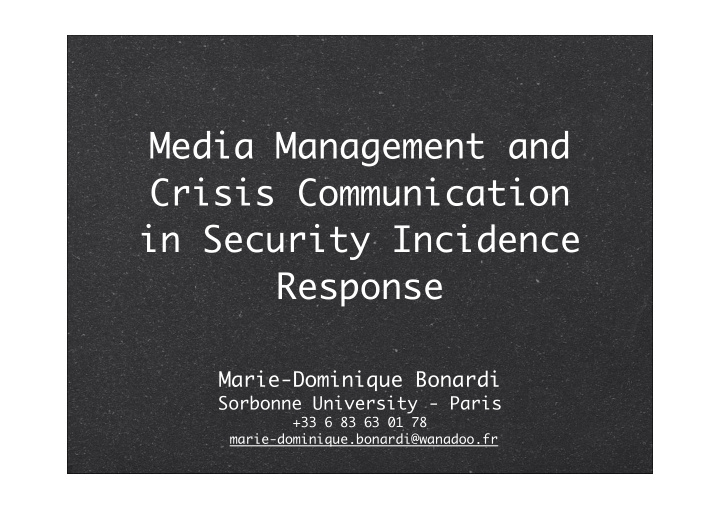



Media Management and Crisis Communication in Security Incidence Response Marie-Dominique Bonardi Sorbonne University - Paris +33 6 83 63 01 78 marie-dominique.bonardi@wanadoo.fr
Agenda Part 1 Understand the media Part 2 Media management: get prepared Part 3 Crisis communications techniques Case study: Security Incident Response communications MD.Bonardi
Part One Understand the media
Understand the Media What the press is/is not What the press wants How does the press work ? MD.Bonardi
What the press is Journalists are often biased They often champion “people” causes Their structure impose a simplification of reality They cover several stories at the same time MD.Bonardi
What the press is Journalists work with tight deadlines They suffer from harsh competition from other media They cover more and more information with shorters delays They are informed more quickly than ever through internet. MD.Bonardi
What the press is not The media are not your friends They are not your ennemy They are not experts in every area They are not aware of all existing news and confidential information MD.Bonardi
What the press wants Meet their deadlines Produce an interesting story: - Check the facts rapidly - Gather quotes/testimonials - Get pictures,soundtracks... MD.Bonardi
What the press wants Get accurate information Speak to the right person Never loose time Their calls to be returned Not to be pressured or threatened MD.Bonardi
How does the press work? Facts Analysis Commentary Balancing Reporting News TV report/ Radio report MD.Bonardi
What is an angle ? MD.Bonardi
News Report From 1.15mn to 1.45mn 25’’ 8’’ 15’’ Testimonials TEMOIGNAGES MD.Bonardi
What is news ? A news is linked with a context Impacting a lot of people Stories that catch people’s attention MD.Bonardi
Part two Media Management: get prepared
Develop efficient Response to the media Evade the Common mistakes What type of interview? Telephone, face to face and Radio. MD.Bonardi
Common mistakes Do not wait to return a journalist phone call Do not give your cellphone number Do not despise/laugh at a journalist Do not give information “off the record” Beware of pre-interview comments Do not tolerate bad behaviors
Common mistakes Do not lose control of what you say Do not lie Do not play ping-pong Do not counter or refute the substance of the questions Do not take back/re-use the negative words of the journalist, even to refute them
Common mistakes Do not over-estimate the journalist’s knowledge Do not expect the press to draw the same conclusion as you from the facts Do not ask what is the journalist’s angle
Master time
The Colombo Effect
What type of interview? Email Telephone Face to face One to many Radio TV
What type of interview? What is this publication ? (business, IT, daily, monthly, etc...) What is the interview context? What is the audience? Who is this journalist? What do I want to say?
What type of interview? Establish the ground rules with the reporter: On the record Not for attribution Background
Telephone interview Don’t start answering questions on the spot. Ask name, contact details, publication and deadline and call the reporter back. Check internally if you’re the right person to talk to him. Prepare/check your points and statements before calling him back.
Face to face interview Fix a timing/day for the interview and stick to it If possible, choose the venue Don’t be late Dress correctly Switch off your mobile phone
Face to face interview Welcome the journalist by using his name Offer him water/coffee Check the venue where the journalist wants to take a picture/movie.
Radio Prepare 15sec to 30sec statement Prepare stricking sentences Prepare stricking metaphors
Part Three Crisis Communications Techniques MD.Bonardi
Remember Your objective in a media interview is to make your point The first words have a greatest impact You win or lose your audience in the first 30 seconds Audience remember what you say first and last MD.Bonardi
Crisis Response Techniques Develop a brief statement to begin each interviews Continually update the information Stick to factual responses Keep calm Show concern for the people involved MD.Bonardi
Basic Response techniques Top of the pyramid: key to controlling responses Logical progression: responding in anticipated sequences Audience benefit: responding to audience self-interest. MD.Bonardi
The Engineers’ Way Background Rational Conclusion/Core message MD.Bonardi
The Media way Core messages Sub-messages Illustration/Examples MD.Bonardi
Prepare a game plan Objective: what you want to accomplish Audience: who your message will reach. Major Points: 3 general “umbrella” points Sub-points: illustrate each sub-point. Give EXAMPLES. Scope: limit your response to your job responsibility. MD.Bonardi
Objective What do you want to accomplish ? => sell a story? => balance a news? => limit coverage? MD.Bonardi
Audience Who is the audience? How are they involved? General Public? Entreprises? Government? Shareolders ? MD.Bonardi
Core Messages Try and Limit them to 3 points This narrows the focus of the media interviews This limits the information the reporter has to work with Focus on relevant positive, short & easily understandable points MD.Bonardi
Sub-Messages Relevant facts & figures that substantiate, reinforce or explain your core message Provide metaphors that illustrate your first point clearer MD.Bonardi
Examples/ Illustration Provide examples that illustrate your points Provide testimonials from an external and neutral actor to back-up your statement (analysts...etc) MD.Bonardi
Prepare Q&A Limit it to 6/8 questions Have 3/4 answers covering ALL possible questions “What if..” scenarios Role-play different types of reporters (agressive,abrasive...) MD.Bonardi
Case study Security Incidence Response Communications MD.Bonardi
Recommend
More recommend